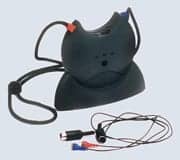In recent years, the challenge among hearing instrument manufacturers has been to create a hearing system that operates in a manner similar to the human ear, offering natural sound quality in a multitude of listening situations, functioning automatically, and adapting instantaneously to every change in the sound environment. Listening comfort, feedback control, elimination of occlusion, and flexibility to adjust to the wearer’s needs also have been primary developmental considerations.
To accomplish these goals, Bernafon collaborated with researchers at the ETH (Swiss Federal Institute of Technology) and the Ear, Nose and Throat Clinic at the University Hospital in Zurich to develop a new non-linear approach to hearing loss compensation. The result is a new-generation device called Symbio which features a processing scheme designed to work differently from other products on the market.
The following article outlines the audiological background for this new DSP product line and provides an introduction for hearing care professionals on its features and use.
Speech in Focus: Using Signal Processing
Hearing loss is probably the most isolating sensory impairment people experience. In addition to loss of audibility, one of the most critical deficits is increased susceptibility to noise. This is largely due to the fact that sensorineural hearing impairment causes abnormally broad auditory filters due to loss of outer hair cell function.1 The main social consequence of hearing loss is increased difficulty in understanding speech—especially in the presence of competing noise. This difficulty is most likely due to a combination of reduced audibility and loss of frequency selectivity.
Hearing instruments are effective in increasing the audibility of sounds; however, they cannot reliably alleviate the effects of reduced frequency selectivity. This results in the often heard comment that hearing instruments improve speech understanding in quiet environments, but are not very effective when there is background noise.

Figure 1. Graphic illustration of multichannel versus a
unified signal processing approach.
Prescription of multichannel hearing instruments, especially those utilizing a large number of independent channels, may only exacerbate the problem (Figure 1). Processing schemes with a large number of channels may reduce the spectral contrasts in the speech signal. This spectral smearing has been found to significantly reduce understanding of speech in both quiet and noise,2 and may also reduce sound quality. In fact, van Schijndel et al.3 found that distorted coding of spectral cues was the main factor associated with reduced speech discrimination in noise for hearing impaired subjects. Distorted coding of spectral cues had greater negative impact than did distorted temporal or distorted intensity cue coding.
A unified signal processing approach called CASI™ (Continuously Adaptive Speech Integrity) is utilized in Symbio. With this approach, flexible input-dependent filter characteristics are applied to the whole signal, allowing frequency-dependent compression without splitting the signal into channels. This approach to signal processing is designed to provide the benefits of multichannel amplification (ie, extremely flexible frequency and compression adjustment), but without the drawbacks and potential degradation of the speech signal caused by spectral smearing.
How is the speech kept in focus? CASI continually analyzes the intensity and dominant frequencies of the incoming signal. Using this information, together with an importance-weighting that favors frequencies critical for speech understanding, the appropriate amount of amplification for a signal is applied at each instant in time. The new instrument is designed to adapt instantaneously to even the most demanding acoustic situations. In this way, any type or configuration of hearing loss is precisely and effectively compensated with amplified signals that maintain the spectral cues of the original signal.4
Employing Directionality
Directionality is one of the few technologies objectively shown to improve speech intelligibility in noise by increasing the signal-to-noise ratio (SNR).5,6,7 Symbio offers three directional models (one BTE and two ITEs). Each has a highly effective, directional-omni microphone with an exceptional AI-DI (Articulation Index weighted Directivity Index). The ITE models have AI-DIs of 5.3 and the BTEs have AI-DIs of 3.9. In light of user preference for control over directionality,8,9 this feature is switchable in the new hearing instruments.
Fitting Tools
Advanced hearing instruments need intelligent software solutions. OASIS plus is Bernafon’s new NOAH-based, 32-bit fitting platform developed to include elements familiar to current OASIS users while introducing new functions specific to Symbio’s sophisticated capabilities. The software includes a newly developed model that takes more individual acoustic factors into account to provide precise hearing compensation.10 Fitting with this software is designed to be extremely easy; a complete set of tools for fine tuning and interactive troubleshooting allows hearing care professionals to quickly solve complex problems. As the name implies, SoundLogic tools are based on sound audiological foundations:
In Situ Audiometry. Hearing assessment performed through the hearing instrument provides more accurate measurement of the hearing loss for any given fitting, taking into account the acoustics of the ear canal while the instrument is inserted. Use of in situ data as the basis for the prescription of amplification may reduce the fine-tuning required. If there is not time to perform in situ supra-threshold measures (ie, UCL, MCL), these data will be recalculated based on the in situ threshold data, so a more accurate starting point for the fitting can still be achieved.
Client Experience Level. New hearing instrument users require a period of adjustment to amplification.11 The Client Experience Level feature permits the hearing care professional to fit the hearing instrument either to full target gain or modified target gain based on the user’s previous experience and hearing loss. Gradual introduction of amplification in a controlled manner may increase comfort and result in better acceptance of hearing instruments.
Four Client Experience Levels are offered, including a proprietary level for clients accustomed to linear amplification. Although it is recommended that the levels be changed during the first few weeks of hearing instrument use, the decision as to how long each client should be kept at a certain level is up to the hearing care professional and the client. The ultimate goal is for each user to achieve full target gain to realize the maximum benefits of their hearing system.
Feedback Manager. Feedback is a familiar problem for both dispensing professionals and hearing instrument users. It affects not only sound quality,12 but can also potentially affect speech understanding. Symbio offers both passive and adaptive feedback control options (for a complete discussion of these types of feedback management systems, see Dillon12).
Some hearing instruments address feedback through limitation of gain over a relatively broad range of frequencies and/or input levels, which reduces the amplification of other speech elements falling in this range and may also degrade sound quality. The new instrument’s intelligent passive feedback manager is designed to reduce gain only at the problem frequencies and input levels. An accurate and fast feedback measurement is made during the fitting to determine problem frequencies and input levels.
The instrument also offers adaptive feedback cancellation that removes feedback from the amplification path, even if the feedback path changes (eg, when the wearer uses a telephone). Adaptive feedback cancellation allows wearers to be fit with larger vents, reducing the likelihood that they will experience occlusion effects. Clinical investigation of the performance of this feature found substantial increases in available gain during fitting, as reported by RA Bentler et al (Bernafon Alaska Project, University of Iowa).

The Adaptive Feedback Canceller works by comparing the hearing instrument output with the input from the hearing instrument microphone, determining which portion of the microphone signal is feedback, and subtracting this from the incoming signal prior to the amplification block (Figure 2). In this way, the incoming signal is “cleansed” of feedback, and the desired gain is applied to the signal.
Fitting Assistant. The Fitting Assistant offers two tools designed to involve clients in their own hearing rehabilitation, and support hearing care professionals in solving potentially complex fitting problems.
The first tool is called Client Interactive, a series of troubleshooting prompts that are designed to guide the dialog between the hearing care professional and client. The goal is to reach a specific adjustment to the hearing instrument response.
The second tool is the Questionnaire, a series of questions to be printed out at the fitting appointment and completed by the client shortly before the follow-up visit. The hearing care professional can then select “problem” questions and enter the client’s response in software. The software then implements the recommended adjustment(s).
Dynamic Frequency Mapping. Traditionally, hearing care professionals have looked at graphs of dBHL vs frequency and/or graphs of input vs output. To adjust the instrument response, modifications are made to the frequency response or the compression (input/output). Because these two responses are intrinsically linked, a change in one always results in a “hidden” change in the other.

With the new hearing instrument, the traditional 2-dimensional views (frequency response and input/output graphs) are still present. However, a 3-dimensional view is offered called Dynamic Frequency Mapping—a visualization of the instrument response over frequency and input simultaneously, giving the hearing care professional a better overview of the true hearing instrument performance (Figure 3).
This mapping works in combination with a “selection grid,” a matrix of 9 frequency points that can be programmed at 9 separate input levels, making a total of 81 individual adjustment points available for precision tuning. Although the output can be manipulated at any of the 81 control points, the instrument response between each of these points is always a smooth curve, with the desired result of providing a continuous, comfortable hearing experience for the user.
Soft Sound Suppression. The use of compression in hearing instruments is widely accepted as a solution to the problem of abnormal growth of loudness commonly associated with hearing loss. The main tenet of compression is the application of higher gain for lower input levels than for high input levels.
However, when compression is used over the whole range of input levels, the gain applied to very low inputs (eg, less than 45-50 dB SPL) can be very high. Many of the sounds in this low intensity region are ambient noises generated by such things as air conditioners and refrigerators. Listening to these sounds can be tiring and annoying for hearing-impaired people. For this reason, expansion has been successfully utilized in many hearing instruments. Expansion is the opposite of compression: it reduces the gain applied to low-level signals. This has been shown to be effective in reducing the presence of low-level noise.12
Three, levels of soft sound suppression can be programmed during the fitting to help ensure that low-level background sounds do not cause unwarranted listener fatigue. Soft Sound Suppression is suitable for all patients, but may be especially useful for patients not accustomed to compression amplification (eg, new users, or experienced users who have previously worn linear amplification).
Situational Verification Tool. If a fitting requires fine-tuning, the Situational Verification Tool can be used to guide hearing care professionals to the specific area of the instrument response in need of adjustment. The tool includes environmental sounds that have been carefully treated to provide accurate and meaningful information on which to base the fine tuning of the fitting. The sounds have been filtered to the octave of the dominant frequency, and adjusted to decrease the modulation in order to maximize the accuracy of the sound level measurement.
The hearing instrument system has been developed to combine the advantages of sample sounds with in situ verification of the signal level, ensuring greater accuracy in fine tuning.13 This is meant to provide more accuracy than systems containing a single calibration signal. The situational verification tool system is available for use at any stage of the fitting, but is also integrated with the Client Interactive Fitting Assistant to help zero-in on specific frequency areas that the client finds unsatisfactory. Intuitive software leads the dispenser through a set of proposed adjustments that can then be evaluated by the client, allowing quick, easy and accurate adjustment of the instrument response. This is designed to provide a more controlled and accurate approach to fine-tuning, increasing the probability of client satisfaction.
| This article was submitted to HR by Anna O’Brien, MAud, and Lorrie Scheller, MS, who are audiologists, and Tom Scheller, BSEE, who serves as audiology profession manager at Bernafon AG, Bern, Switzerland. Correspondence can be addressed to HR or Lorrie Scheller, Bernafon AG, Morgenstrasse 131, 3018 Bern, Switzerland; email: [email protected]. |
References
1. Moore BCJ. Cochlear Hearing Loss. London: Whurr Publishers Ltd;1998.
2. Boothroyd A, Mulhearn B, Gong J, Ostroff J. Effects of spectral smearing on phoneme and word recognition. J Acoust Soc Amer. 1996;100(3):1807-1818.
3. van Schijndel NH, Houtgast T, Festen JM. Effects of degradation of intensity, time, or frequency content on speech intelligibility for normal-hearing and hearing-impaired listeners. J Acoust Soc Amer. 2001;110(1):529-542.
4. O’Brien AJ. More channels are better, right? Audiology Online. Available at: http://www.audiologyonline.com. Accessed April 8, 2002.
5. Killion M, Schulein R, Christensen L, Fabry D, Revit L, Niquette P, Chung K. Real-world performance of an ITE directional microphone. Hear Jour. 1998;51(4):24-38
6. Ricketts T, Dahr S. Comparison of performance across three directional hearing aids. J Amer Acad Audiol. 1999;10(4):180-189
7. Valente M, Schuchman G, Potts LG, Beck LB. Performance of dual-microphone in-the-ear hearing aids. J Amer Acad Audiol. 2000;11(4):181-189
8. Kochkin S. MarkeTrak VI: Consumers rate improvements sought in hearing instruments. Hearing Review. 2002; In press.
9. Preves DA, Sammeth CA, Wynne MK. Field trial evaluations of a switched directional/omnidirectional in-the-ear hearing instrument. J Amer Acad Audiol. 2000;10(5):273-284
10. Hockley N, Scheller T, Butsch K-D, Johannesson RB. From transducer to tympanic membrane: A new acoustical model. Poster presented at: Annual Meeting of the American Academy of Audiology; April 2002; Philadelphia.
11. Gatehouse S. The time course and magnitude of perceptual acclimatization to frequency responses: Evidence from monaural fitting of hearing aids. J Acoust Soc Amer. 1992;92(3):1258-68.
12. Dillon H. Hearing Aids. Sydney, Australia: Boomerang Press; 2000.
13. O’Brien AJ, Scheller T. The Fine tuning of hearing instruments: What, where and how? Poster presented at: Annual Meeting of the American Academy of Audiology; April 2002; Philadelphia.





